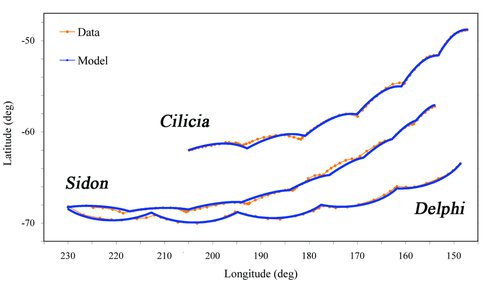2009 Annual Science Report
 University of California, Berkeley
Reporting | JUL 2008 – AUG 2009
University of California, Berkeley
Reporting | JUL 2008 – AUG 2009
Water Delivery to the Surface of Icy Satellites
Project Summary
Oceans below the icy surface of the moons of Saturn and Jupiter may be habitable. Sampling this ocean directly is difficult. This ocean water may, however, erupt onto the surface of these moons and there are active and fossil features that suggest this is possible. We show, however, that cracks are unlikely to penetrate all the way through the ice shell. We also develop models for the coupled orbital and interior evolution of icy satellites.
Project Progress
The icy satellites in the outer solar system may have habitable subsurface oceans. This ocean water may be delivered to the surface through cryovolcanism. Features such as chaos on Europa or the geysers on Enceladus may be manifestations of such eruptions.
Erupting liquid water is challenging because water is more dense than ice. We showed (Manga and Wang, GRL 2007) that gradual cooling of icy satellites can pressurize subsurface oceans and promote water eruption. In Rudolph and Manga (Icarus 2009) we calculated the depth to which cracks could penetrate and found that they are unlikely to reach a subsurface ocean.
We have also developed models to relate tectonic features to the sources of stress in the ice shell, in particular stresses that originate from orbital dynamics. We have now found geologic evidence of a large and varying obliquity of ~1° in both cycloid and strike-slip fault patterns. Obliquity can have a large impact on heat generation within Europa thus influencing the habitability of the ocean.
By comparing model predictions for cycloidal features on Europa (assuming they are produced by tensile failure of the ice shell) with observed cycloids, we obtain constraints of the origin of stresses that result in tectonic activity on Europa. Our models suggest a tectonically significant contribution of obliquity to the stress and we do not require polar wander.
-
PROJECT INVESTIGATORS:
-
PROJECT MEMBERS:
Michael Manga
Project Investigator
Mark Richards
Collaborator
Max Rudolph
Doctoral Student
Alyssa Sarid
Doctoral Student
-
RELATED OBJECTIVES:
Objective 1.1
Formation and evolution of habitable planets.
Objective 2.2
Outer Solar System exploration
